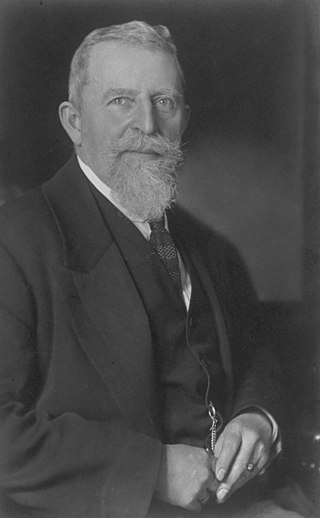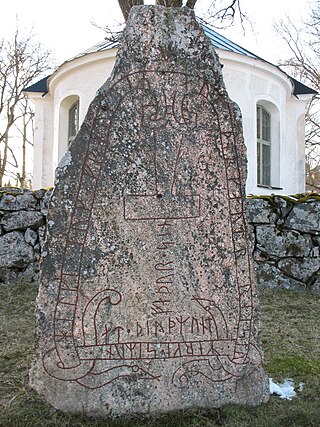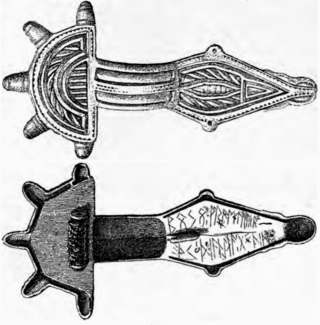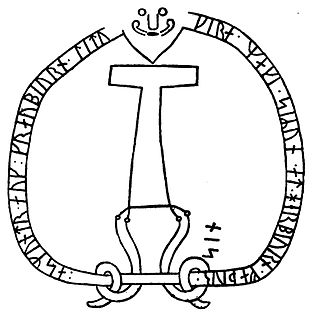External links
- Personal website of Robert Nedoma
- Robert Nedoma at the website of the University of Vienna
- Robert Nedoma at the website of the German Academic Exchange Service
- Robert Nedoma in the OPAC of Regesta Imperii
Robert Nedoma | |
|---|---|
| Born | 1961 Ternitz, Austria |
| Nationality | Austrian |
| Academic background | |
| Alma mater | |
| Academic work | |
| Discipline | Germanic philology |
| Institutions |
|
| Main interests | Early Germanic culture |
Robert Nedoma (born 1961) is an Austrian philologist who is Professor at Department for Scandinavian Studies at the University of Vienna. He specializes in Germanic studies and Old Norse studies.
Robert Nedoma was born in 1961 in Ternitz,Austria. He gained his PhD at the University of Vienna in 1987 with a dissertation on Wayland the Smith,and subsequently worked as a researcher at the Institute for Germanic Studies at the University of Vienna. He completed his habilitation in 2004 with a thesis on Germanic names and runes,and was appointed an associate professor at the University of Vienna in 2010. Since 2019,Nedoma has been Professor at the Department for Scandinavian Studies at the University of Vienna.
Nedoma specializes in Old Norse language and Old Norse literature,runology,Germanic names,and Germanic Antiquity. He is the author of a number of articles for the second edition of the Reallexikon der Germanischen Altertumskunde ,and an editor of many journals,including Die Sprache , Philologica Germanica and North-Western European Language Evolution.
Nedoma was elected a member of the Royal Gustavus Adolphus Academy in 2018,a member of the Norwegian Academy of Science and Letters in 2020,and a member of the Austrian Academy of Sciences in 2022.

The Pforzen buckle is a silver belt buckle found in Pforzen, Ostallgäu (Schwaben) in 1992. The Alemannic grave in which it was found dates to the end of the 6th century and was presumably that of a warrior, as it also contained a spear, spatha, seax and shield. The buckle is of the Alemannic Weingarten type.

Otto Eduard Gotfried Ernst Höfler was an Austrian philologist who specialized in Germanic studies. A student of Rudolf Much, Höfler was Professor and Chair of German Language and Old German Literature at the University of Vienna. Höfler was also a Nazi from 1922 and a member of the SS Ahnenerbe before the Second World War. Höfler was a close friend of Georges Dumézil and Stig Wikander, with whom he worked closely on developing studies on Indo-European society. He tutored a significant number of future prominent scholars at Vienna, and was the author of works on early Germanic culture. Julia Zernack refers to him as the "perhaps most famous and probably most controversial representative" of the "Vienna School" of Germanic studies founded by Much.

The Ring of Pietroassa or Buzău torc is a gold torc-like necklace found in a ring barrow in Pietroassa, Buzău County, southern Romania, in 1837. It formed part of a large gold hoard dated to between 250 and 400 CE. The ring itself is generally assumed to be of Roman-Mediterranean origin, and features a Gothic language inscription in the Elder Futhark runic alphabet.

The Meldorf fibula is a Germanic spring-case-type fibula found in Meldorf, Schleswig-Holstein in 1979. Though the exact circumstances of the recovery of the fibula are unknown, it is thought to have come from a cremation grave, probably that of a woman. On typological grounds it has been dated to first half of the 1st century CE, and possibly bears the oldest runic inscription found to date.
The Altuna Runestone (Altunastenen), listed as U 1161 in the Rundata catalog, is a Viking Age memorial runestone with images from Norse mythology that is located in Altuna, Uppland, Sweden.

Rudolf Simek is an Austrian philologist and religious studies scholar who is Professor and Chair of Ancient German and Nordic Studies at the University of Bonn. Simek specializes in Germanic studies, and is the author of several notable works on Germanic religion and mythology, Germanic peoples, Vikings, Old Norse literature, and the culture of Medieval Europe.

Rudolf Much was an Austrian philologist and historian who specialized in Germanic studies. Much was Professor and Chair of Germanic Linguistic History and Germanic Antiquity at the University of Vienna, during which he tutored generations of students and published a number of influential works, some of which have remained standard works up to the present day.

The Stenkvista runestone, designated as runic inscription Sö 111 in the Rundata catalog, is a memorial runestone located near the church at Stenkvista, which is two kilometers east of Skogstorp, Södermanland County, Sweden, which was formerly part of the historic Södermanland, and which features a depiction of Thor's hammer, Mjöllnir. This runestone is one of several runestones in Scandinavia that has a dedication to Thor. While the tradition of carving inscriptions into boulders began in the 4th century and lasted into the 12th century, most runestones in Scandinavia date from the late Viking Age.

The Frei-Laubersheim fibula is a silver-gilt bow-style fibula found in Frei-Laubersheim, Bad Kreuznach (Rhineland-Palatinate) in 1872. The grave in which it was found dates to approximately the 6th century, and was that of a presumably Frankish woman. The fibula is one of a pair, and bears a runic inscription in the Elder Futhark.

Sö 86 is the Rundata catalog number for a Viking Age memorial runic inscription located in Åby, which is about one kilometer north of Ålberga, Södermanland County, Sweden, and in the historic province of Södermanland. The inscription features a depiction of the hammer of the Norse pagan god Thor named Mjöllnir and a facial mask.

Wolfgang Krause was a German philologist and linguist. A professor at the University of Göttingen for many years, Krause specialized in comparative linguistics, and was an authority on Celtic studies, Tocharian languages, Germanic studies, Old Norse and particularly runology.

Danish Runic Inscription 48 or DR 48 is the Rundata catalog number for a Viking Age memorial runestone from Hanning, which is about 8 km north of Skjern, Denmark. The runic inscription features a depiction of a hammer, which some have interpreted as a representation of the Norse pagan god Thor, although this interpretation is controversial.

Hermann Reichert is an Austrian philologist at the University of Vienna who specializes in Germanic studies.

Heinrich Beck was a German philologist who specialized in Germanic studies. A Professor of Ancient German and Nordic Studies at Saarland University and later the University of Bonn, Beck was a co-editor of the second edition of Reallexikon der Germanischen Altertumskunde and one of the world's leading experts on early Germanic culture.
Wilhelm Heizmann is a German philologist who is Professor and Chair of the Institute for Nordic Philology at the University of Munich. Heizmann specializes in Germanic studies, and is a co-editor of the Germanische Altertumskunde Online.

Otto Gschwantler was an Austrian philologist who was head of the Institute for Germanic Studies at the University of Vienna. He specialized in the study of early Germanic literature.
Klaus Böldl is a German philologist who specializes in Old Norse studies. Böldl was born in Passau and studied Nordic philology, German philology and comparative literature at the universities of Munich and Lund University. Böldl received his Ph.D. in philology at Munich in 1999, where he completed his habilitation in 2005. Since 2007, Böldl has been Professor of Scandinavian Medieval Studies at the Nordic Institute of the University of Kiel.

Klaus Düwel was a German philologist who specialized in Germanic studies. A professor at the University of Göttingen, he was recognized as one of the world's leading experts on Germanic Antiquity.
Fritz Paul is a German philologist who specializes in Scandinavian studies.
Benjamin Sigmund Oehrl is a German archaeologist and philologist who specializes in Germanic studies.